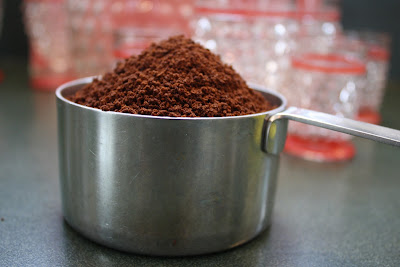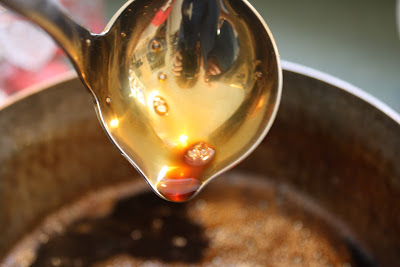I must say that I have never been a big fan of Pop-Tarts. I find the pastry bland and crumbly-dry and the filling way too sweet and gritty. I will also admit to keeping them stocked in my pantry, calling them "breakfast" when I'm
swearing yelling at my 15 year old to get out of bed and get to school on time. To ease my guilty conscience, I tell myself that Pop-Tarts are the equivalent of toast and jam...errrr...okay, yeah, I know that's a stretch, especially those s'mores "flavored" ones he seems to favor. But you know, sometimes a mother's gotta do...you know the rest.
So, imagine my delight when I found a recipe for homemade Pop-Tarts in, yes, you guessed it, Joanne Chang's beautiful baking book,
Flour. By now some of you may be sick of hearing me heap mounds of sugary praise on her book, but honestly, it's by far the best pastry and baking cookbook I have or will ever own -
evah, as we Bostonian's like to say.
Suffice it say, once you try one these homemade Pop-Tarts, you'll never go back. Imagine delicious, fresh fruit jam (pick your favorite flavor), folded inside the flakiest, most buttery pastry imaginable, then topped with a vanilla-y glaze and sprinkles (optional). You will be the envy of your co-workers and your kids and their friends will think you are the coolest parent in the world once you bake up a batch of these. The dough can be made in advance, and the assembly and baking process is relatively quick and easy. If you're really pressed for time, you can use pre-made pastry dough (in the freezer section at most grocery stores), which will be good, but not as decadent as the recipe below. Either way, you will be a pop rock star (get it?), and when you have teenagers in the house, you take the props where you can get 'em.
Homemade Pop-Tarts (From Joanne Chang's,
Flour cookbook)
1 recipe Pate Brisse (recipe below)
1 egg, lightly beaten
1 cup raspberry jam (or whatever you like)
Simple Vanilla Glaze
1 cup confectioners' sugar
1/4 tsp. vanilla
2-3 Tbsp. water
Rainbow sprinkles for sprinkling (optional)
Preheat the oven to 350 F.
Remove dough from the refrigerator and divide it in half. Press each half into a rectangle. On a lightly floured surface, roll out each half into a 14-by-11 inch rectangle. Using a paring knife, lightly score on rectangle into eight 3 1/2-by-5 1/2-inch rectangles (about the size of an index card).
Brush the top surface of the entire scored rectangle with the egg. Spoon 2 tablespoons of the jam in a mound in the center of each scored rectangle. Lay the second large dough rectangle directly on top of the first. Using fingertips, carefully press down all around each jam mound, so the pastry sheets adhere to each other.
Using a pizza cutter, knife of fluted roller, and following the scored lines, cut the layer dough into 8 rectangles. Place the rectangles, well spaced, on a baking sheet lined with parchment paper.
Bake for 35-40 minutes, or until the tops of pastries are evenly golden brown. Let cool for about 30 minutes.
To make the glaze: While the pastries are cooling, in a small bowl, whisk together the confectioners' sugar, vanilla and enough of the water to make a smooth, pourable glaze.
When the pastries have cooled for 30 minutes, brush the tops evenly with the glaze, then sprinkle them with rainbow sprinkles. Let stand 10-15 minutes to set before serving.
Pate Brisee
1 3/3 cups unbleached all purpose flour
1 Tbsp. sugar
1 tsp. salt
1 cup cold unsalted butter, cut into 12 pieces
2 egg yolks
3 Tbsp. cold milk
Using a stand mixer fitted with the paddle attachment, mix together the flour sugar and salt for 10-15 seconds. Scatter the butter over the top. Mix on low speed for 1-1 1/2 minutes, or just until the flour is no longer bright white and hold together when you clump it and lumps of butter the size of pecans are visible throughout.
In a small bowl, whisk together the egg yolks and mil until blended. Add to the flour mixture all at once. mix on low speed for about 30 seconds, or until the dough just barely come together. It will look really shaggy and more like a mess than dough.
Dump the dough out onto an unfloured work surface, then gather it together into a tight mound. Using your palm and staring on one side of the mound, smear the dough bit by bit, starting at the top and of the mound and then sliding your palm down the side and along the work surface, until most of the butter chunks are smeared into the dough and the dough comes together. Do this once or twice on each part of the dough, moving through the mound until the whole thing has been smeared into a cohesive dough with streaks of butter.
Gather up the dough, wrap tightly in plastic wrap, and press down to flatten into a disk about 1 inch thick. Refrigerate for at least 4 hours before using.
 Here's how it all started. Yesterday was my birthday, so to celebrate, my angel-husband assembled (most) of our family to go to the Summer Shack - one of my favorite seafood restaurants in my original hometown, Cambridge, MA. Because I'm spoiled rotten, I was fabulously feted with the best company ever, incredible food (oysters and prosecco - seriously, dude, bury me with that combo), and....way too many gifts.
Here's how it all started. Yesterday was my birthday, so to celebrate, my angel-husband assembled (most) of our family to go to the Summer Shack - one of my favorite seafood restaurants in my original hometown, Cambridge, MA. Because I'm spoiled rotten, I was fabulously feted with the best company ever, incredible food (oysters and prosecco - seriously, dude, bury me with that combo), and....way too many gifts.
















































